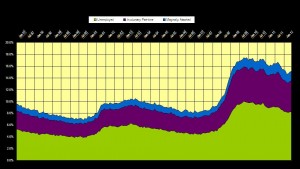by O'Farrell | Apr 13, 2013 | Featured, O'Farrell's Blog
Great week this week for O’Farrell CM clients. Mike and Russ have accepted offers. Lecia starts a three-month contract on Monday. Nancy has an offer in hand and may have another coming. Donald, Tim and Randy have already started new jobs (just found out this week). David and Wanda are both getting close. Great to work with all of you as coach and client. Congrats to all nine of you for making it happen! – Dave
by O'Farrell | Apr 1, 2013 | Featured, O'Farrell's Blog
-

-
Craig Kimbrel
-

-
Fredi Gonzalez
-

-
Roger McDowell
Well, this is embarrassing. Seems I failed my job interview with the Atlanta Braves. Thought it was some kind of April Fool’s joke.
I met with the Braves on Friday afternoon. They were back in Atlanta for a couple of days of practice between spring training and opening night. Networking was the key to setting up the meeting. General Manager Frank Wren lives here in Peachtree City, and it turns out that we have a mutual friend.
Anyway, I met with manager Fredi Gonzalez and pitching coach Roger McDowell at Turner Field. We didn’t talk long; I wanted to tell them about all the blogs I’d read and webinars I’d watched about pitching. They just wanted to see me pitch. We left Gonzalez’ office and headed out to the bullpen.
Bullpen coach Eddie Perez had his catching gear on and set up behind the plate. An assistant held up a radar gun. I threw my first pitch. They said it was 61 miles an hour. I said there must be something wrong with the gun; I was expecting to throw in the low 90’s. I tried harder next time. That one was 58 miles an hour. The guy with the gun pointed it at a pitching prospect who was on the mound next to me. He threw a pitch at 93 miles an hour. Guess the radar gun wasn’t malfunctioning after all.
All these thoughts were racing through my head. “What am I doing wrong?” I went over all the things I’d read about or watched on how to get the most leverage, torque, and arm whip to maximize speed. I tried even harder on the third pitch; 57. Seems the harder I tried, the slower I threw. I think I saw closer Craig Kimbrel snickering a little bit.
Finally I told them that I’m not really a power pitcher; I’m more like Greg Maddux. I’m going to strike batters out with my craftiness – movement, location, and change of speed. The assistant put down the gun, picked up a bat and stood in the right-handed batter’s box. Gonzalez said, “Okay, the count is 0-2; throw a slider down and away just outside the strike zone.” I came set, went into my wind up, and hurled my slider to the plate. It was up and in. Ball one. More snickers.
Again I reviewed all I’d read about how to maximize control. I’d even gotten a refresher this past week from Doug Brantley, owner of Five Star Baseball & Softball here in Peachtree City. He told me not to forget the three imperatives of great location: put your front foot down in the exact same spot on every pitch, keep your chin over your front knee, and use the exact same arm slot and release point on every pitch.
“Okay, 1-2, you can still get the hitter out; another slider down and away.” My second pitch was halfway between my target and the location of my first pitch. In other words it was belt high right down the middle. Kimbrel whistled like a bomb was falling and then made the sound of an explosion. I’d crashed and burned. Gonzalez and McDowell said they’d seen enough and told me I should consider another career.
Several of you pointed out after my post last week that I’d never stepped onto a field or picked up a ball in my quest to be the Braves starting pitcher. I scoffed at you guys because you wanted me to practice. I thought if I could just get an interview, I would do great when it really counted. I hate to admit it, but practice really is key if you want to win a job in the Major Leagues. Maybe I should have paid for a few lessons with Brantley.
Come to think of it, practice is the key if you want to win a job in a normal company or organization too. I know that many of you are reading blogs, watching webinars and participating in free seminars. Maybe that’s not enough. In fact, maybe these things are giving you a false sense of security – just like I had with the Braves.
Today I’ll be watching Braves opener on TV just like the rest of you; and thinking of what might have been.
What are you doing to prepare yourself for your tryout?
Copyright © 2013 / Dave O’Farrell / All Rights Reserved
by O'Farrell | Mar 25, 2013 | Featured, O'Farrell's Blog
-

-
Watch me on opening day
-

-
Coaching my son in 2005
-

-
Austin, the ace of my staff
I have wonderful news. I’m going to be the opening day pitcher for the Atlanta Braves. I can see the headline now, “O’Farrell is Opening Day Starter for Atlanta Braves” on ESPN’s “bottom line” ticker.
Yes, I will be at the top of the Brave’s rotation. I’ll be the ‘ace’ on the Braves staff. I will face the Philadelphia Phillies at Turner Field next Monday 1 April 2013. I’ll bet you think I’m crazy, but I am way beyond confident that I will perform well when the pressure is on. You can go ahead and put the Braves down for a win on opening day.
BTW, you may have seen or read that Tim Hudson is the opening day starter. That’s just because Fredi Gonzalez and Roger McDowell haven’t seen me pitch yet.
No, I’m not crazy. Here’s why:
- I’ve been a baseball fan all my life. My grandparents took me to games to see players like Hank Aaron, Joe Torre, Felipe Alou, Eddie Mathews and Phil Niekro when I was a kid.
- I watch as many baseball games as I can on TV. Many times the analyst is a Hall of Frame pitcher like John Smoltz, Orel Hersheiser, or Don Sutton.
- I paid close attention when my son received pitching instruction several years ago. Our favorite coach, Estaban Maldanado, played in the Houston Astros’ farm system.
- A friend gave me a video produced by the National Pitching Association; it’s hosted by Doctor Tom House. He’s coached Nolan Ryan, Randy Johnson and Mark Prior, to name a few.
- I have the history of baseball from PBS on video: “Baseball: A Film by Ken Burns.” I’ve watched all 14 two-hour episodes.
- I’m a member of several baseball communities on LinkedIn. I read the discussions and ‘like’ or ‘comment’ on a few each week.
- I follow a lot of teams and players on Facebook.
- I read blogs about pitching all the time.
- I went to a free two-hour class on pitching.
- I have a collection of 722 baseball cards with 68 autographs, including many pitchers.
- I’ve read several books about the mechanics and strategy of pitching.
- I have authentic Braves’ jerseys (in all five colors) with my name and number on the back.
- I’ve read Greg Maddox’ biography. When he was 15 a coach taught him how to throw balls (not strikes) to get the hitter out.
You may be wondering why I’ve been at JobSeekers each Friday instead of being with my teammates in Orlando for spring training. They’re just practicing down there. It’s not the real thing. Why would I waste my time practicing when I can be in Peachtree City helping you guys get jobs?
Even better, I won’t miss many JS meetings because when the Braves see how good I am, they will allow me to continue my job at O’Farrell Career Management and my volunteer work with JobSeekers. I’ll simply fly in and out of town on game day. Since pitchers only have 16 starts per year on the road, the time lost in Peachtree City will be minimal.
Of course, we will be the playoffs…
One of my clients read a draft of this article and pointed out that I haven’t thrown a single pitch in the off season – much less a pitch in a real game. He thought I should practice. Practice? And waste my time and money on training? I’ve got better things to do. When the Braves find out how many blogs I’ve read about pitching, I’m sure they will hire me.
You probably want to write and wish me good luck, but that’s really not necessary. Luck isn’t necessary. I am prepared, and preparation beats luck every time.
– Dave O’Farrell, #13, RHP, Atlanta Braves
Copyright © 2013 / Dave O’Farrell / All Rights Reserved
by O'Farrell | Oct 9, 2012 | O'Farrell's Blog
 If you look beyond the unemployment figures you will see that underemployment is the insidious burden on our economy. You will see families who are counted as success stories by the Bureau of Labor Statistics, but who are unable to pump fuel in the economic engine that drives our economy.
If you look beyond the unemployment figures you will see that underemployment is the insidious burden on our economy. You will see families who are counted as success stories by the Bureau of Labor Statistics, but who are unable to pump fuel in the economic engine that drives our economy.
– – – – –
On 1 October 2007, Chris and Karin Callahan* were earning $100K per year. Along with their three kids – two in elementary and one in middle school – they were living their version of the American Dream.
Six months later Chris was laid off from his $50K job as a production manager. He found a new job as a production supervisor nine months later. He’s held this $40K job for the past 45 months.
Karin kept her $50K job as a financial analyst until 30 September 2008. In the next two years she scraped and scrapped and worked a series of temporary jobs for a total of 15 out of those 24 months. Each job paid $14 per hour, which is $28K annualized. Two years ago she landed a good job as an accounting specialist and now earns $45K annually.

For the past two-plus years Chris and Karin have been fully employed. They do not appear anywhere on the Bureau of Labor Statics’ radar screen. Even though they are earning 85% of what they used to make in the good old days, they are counted as a BLS success story. Most families, if they tighten their belts and stretch their dollars, can live on 85% of their best-ever income.
The Callahan’s story reveals the underlying burden on our economy. The Callahans have never recovered from hitting bottom four years ago in November 2008 – the middle of a three-month stretch when they had no money coming in except for unemployment. In fact, instead of earning $500K in the past five years, they have earned only $350K, or 70% of what they might have earned. The $150K deficit was offset by only $25,000 of unemployment insurance benefits.
With the $125K shortfall in the past five years, here’s their current situation:
1. They are downing in debt.
They are behind on their mortgage, utilities and credit cards. Their cards are maxed out; 95% of their credit card debt is for utilities, groceries, car repairs and other essential items. Creditors are hounding them. They can’t take advantage of the lowest mortgage rates in memory, nor can they refinance because of their poor credit rating. They can’t sell their house either, because they are upside down on their mortgage – its value has dropped 16% from its peak in 2007, according to the Federal Housing Finance Agency.
2. They aren’t buying durable goods.
They aren’t buying cars, appliances or flat-panel televisions. Their main form of entertainment is a 20-year old 27-inch TV. They rent one-dollar movies from Redbox on Friday evenings. Their old refrigerator with the broken icemaker might last another year. They don’t entertain except for family, so they haven’t remodeled their kitchens, bathrooms or family room.
3. They don’t have any disposable income.
They aren’t dining out, going on vacation, or stopping at Starbucks. Their main priority is keeping their three rapidly-growing children in clothes that fit. They cut corners wherever they can; Karin replaces her contacts lenses every three months instead of the recommended once per month. They are unable to give money to their church.
Underemployment: The Insidious Burden
This is the insidious burden that is holding the economic recovery down. The Bureau of Labor Statistics counts the Callahan family as a success, but they are barely getting by. Some politicians call this a ‘win’ – when it’s a draw at best. The bottom line is that the Callahans – like millions of other families – are not pumping fuel in the economic engine that drives our economy.
The latest report from the Bureau of Economic Analysis says our gross domestic product (GDP) slowed to an annualized rate of 1.3% in the second quarter, down from 2.0% in the first quarter of 2012. A growth rate below 2% isn’t enough to lower the unemployment rate. Consumer spending – which accounts for about 70% of our economic activity – is slowing too.
Real personal consumption expenditures increased 1.5% in the second quarter of 2012, compared with an increase of 2.4% in the first. Durable goods decreased 0.2% in the second, in contrast to an increase of 11.5% in the first. Nondurable goods increased 0.6% in the second, compared with an increase of 1.6% in the first quarter.
The Callahans are working, but their lack of spending prevents other Americans from getting back to work.
How many families are there like this? The Bureau of Labor Statistics, which is very good at measuring things, says this data is impossible to measure.
One measure that correlates to this decline is the real median household income. The U.S. Census Bureau has not released data for 2011 or 2012, but there have been studies by former Census bureau income experts who now work for Sentier Research. The Sentier data shows a $4,631 drop in real median household income – from $55,309 down to $50,678 – since December 2007. That’s an 8.4% drop.
The Callahans are fighting back. The challenges they have faced as a family have brought them closer together. Their marriage is stronger. Their kids are healthy and happy. Their oldest son started college a few weeks ago; his Hope Scholarship is a big help, and he’s commuting to school to cut down on expenses. There are no flowers in their beds, but there is hope in their hearts as they await the dawn of a brighter day.
– – – – –
*This story is a composite based on real families and comes from conversations with my clients. The names and details in the story are fictitious.
by O'Farrell | Jul 6, 2012 | O'Farrell's Blog

Unemployment is unchanged at 8.2%
The unemployment figures came out this morning. Here’s the official report without the media spin:
The Employment Situation – June 2012
Friday 6 July 2012 8:30 a.m. (EDT)
Nonfarm payroll employment continued to edge up in June (+80,000), and the unemployment rate was unchanged at 8.2 percent, the U.S. Bureau of Labor Statistics reported today. Professional and business services added jobs, and employment in other major industries changed little over the month.
The number of unemployed persons (12.7 million) was essentially unchanged in June, and the unemployment rate held at 8.2 percent. Among the major worker groups, the unemployment rate for blacks (14.4 percent) edged up over the month, while the rates for adult men (7.8 percent), adult women (7.4 percent), teenagers (23.7 percent), whites (7.4 percent), and Hispanics (11.0 percent) showed little or no change. The jobless rate for Asians was 6.3 percent in June (not seasonally adjusted), little changed from a year earlier.
In June, the number of long-term unemployed (those jobless for 27 weeks and over) was essentially unchanged at 5.4 million. These individuals accounted for 41.9 percent of the unemployed.
Both the civilian labor force participation rate and the employment-population ratio were unchanged in June at 63.8 and 58.6 percent, respectively. The number of persons employed part time for economic reasons (sometimes referred to as involuntary part-time workers) was essentially unchanged at 8.2 million. These individuals were working part time because their hours had been cut back or because they were unable to find a full-time job.
In June, 2.5 million persons were marginally attached to the labor force, down from 2.7 million a year earlier. (These data are not seasonally adjusted.) These individuals were not in the labor force, wanted and were available for work, and had looked for a job sometime in the prior 12 months. They were not counted as unemployed because they had not searched for work in the 4 weeks preceding the survey.
Among the marginally attached, there were 821,000 discouraged workers in June, a decline of 161,000 from a year earlier. (These data are not seasonally adjusted.) Discouraged workers are persons not currently looking for work because they believe no jobs are available for them. The remaining 1.7 million persons marginally attached to the labor force in June had not searched for work in the 4 weeks preceding the survey for reasons such as school attendance or family responsibilities.
Source: U.S. Bureau of Labor Statistics.
23.4 million Americans are in the underutilized workforce
And here is a chart you won’t see anywhere else: a stacked chart of the underutilized workforce for the past 15½ years. The green area is the well-known unemployment rate, the purple area represents Americans who are working part-time that would rather be working full-time, and the blue area represents those who are marginally attached.
The BLS defines marginally attached as, “Persons not in the labor force who want and are available for work, and who have looked for a job sometime in the prior 12 months (or since the end of their last job if they held one within the past 12 months), but were not counted as unemployed because they had not searched for work in the four weeks preceding the survey.”

Underutilized Workforce — Jan 1997 to Jun 2012
(Click to enlarge)
As of today, those figures (in millions) are:
- Unemployed: 12.749 Americans or 8.2% of the civilian labor force
- Involuntary part-time: 8.210 or 5.3%
- Marginally attached: 2.483 or 1.6%
- Total: 23.442 or 15.1% of Americans are in the underutilized workforce
Soon I will blog about a large group of Americans who don’t appear anywhere in these statistics. This is a group of people that the BLS would count as a success, but are struggling to get by.
What do you think of all this?
by admin | Apr 7, 2012 | O'Farrell's Blog
Yogi Berra once said, “Baseball is 90 percent mental, the other half is physical.” Job search is a lot like baseball; before someone learns anything about your qualifications and accomplishments, they notice your attitude. A positive attitude will carry you a long way toward your goals.
We are dedicated to helping clients stay positive and focused throughout their campaigns.
This poem by Ella Wheeler Wilcox uses sailing as a metaphor to describe how people in difficult circumstances have a great deal of control over how they react in trying times. It reminds us that, with God’s help, we are responsible for our outlook, emotions and moods:
The Set of the Sails
One ship drives east, and another west
With the self-same winds that blow;
‘Tis the set of the sails
And not the gales
That decides the way to go.
Like the winds of the sea are the ways of fate,
As they voyage along through life;
‘Tis the will of the soul
That decides its goal,
And not the calm or the strife.
~ Ella Wheeler Wilcox, (US writer, poet, journalist; 1850-1919)
In other words, good and bad things (breezes) happen to all of us. The thing that separates the winners of the world from the rest of the pack is not the events themselves, but how we react to those events. Your attitude — the set of your sails — is the most important factor in whether this transition is successful or not.










